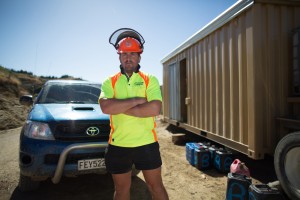Nelson Forests Ltd health and safety manager Les Bak forest safety is about respect, sharing knowledge, keeping it simple and getting workmates to look out for each other. Source: Stuff.co.nz
“You can change beliefs but the way to get long term passion is to improve values.”
A decade ago Bak was managing health and safety for international forest company Weyerhauser over an area of Canada the size of the South Island when his bosses asked him to head to New Zealand to sort out safety issues across its 78,000 hectare Nelson/Marlborough estate.
From 1985 to 1994 the annual national average for workplace fatalities was five per 100,000 people, but for forestry the figure was 121 deaths per 100,000.
One in every 10 forestry workers was seriously injured each year.
When Global Forest Partners bought Weyerhauser’s Nelson/Marlborough forests and Kaituna mill in 2007 Nelson Forests Ltd was born and Bak was made the company’s health and safety manager.
Bak fits the role like a glove. He knows loggers, the industry, the pressures and, in the last 10 years, has helped transform forestry skids into work places where safety is not just a manual in the corner of the smoko shed – it’s part of every action.
Key has been the handover of responsibility to those on the ground; acceptance that knowledge shared is knowledge learned by all; empowering loggers to speak up on problems, hazards and suggesting safer ways of tackling jobs and to acknowledge when they are having a bad day.
“If you teach people to take care of each other they will then take care of themselves,” Bak said.
His safety culture is fast being picked up by loggers and companies nationwide.
Kim Bryant runs Bryant Logging’s Boar crew helped by crew manager Callum Taylor.
Bryant said it was all about getting the guys on-board with planning so there were no hidden surprises. Not only has the crew’s role in managing its logging increased so has its engagement with Nelson Forests.
“We are now working more in partnership with contractors,” said Bak.
Helping men stay safe in an environment where hazards are constant and constantly changing is Bak’s `traffic light’ sign displayed at entry points, on logging skids and in smoko sheds.
The signs tell everyone to stop if they are not comfortable, the risks are high, the plan has changed or the conditions unsafe.
Only if the worker feels good, the plan is good and there are no risks or hazards does the job get a green light.
Another tool is analysing human error. No-one wants a near miss, or worse, in the forest, and few want to talk about it. But by analysing what went wrong and spreading the word everyone learns, Bak said.
The new culture has increased production and safety. It now takes 30% to 40% fewer hours to produce the same wood.
Ten years ago the company was losing 300 to 400 hours a year to accidents from a workforce of 700. That’s now down to 40 to 50 hours, he said.
More importantly it has given loggers a boost.
“People are getting excited about what they can do in the bush when you treat them as professionals,” Bak said.
“It all comes down to getting what you ask for. If you engage you get a better result.”
Taylor said he took his hat off to Bak for what he has done. Accidents are down, attitudes have changed, crews are more stable and their input has increased.
It’s not a great day at Fraser 740’s skid site.
A skidder has hit a stump and a digger is bogged to its cage.
Machinery down, the crew’s packing up for an early knock-off.
Crew boss Glen Holmwood is heading off to sort out the skidder and his manager Mike Green takes over.
The skid is tidy. All the parked utes face outwards, the machinery is in a row, the log stacks are neat and a warratah is felling trees a safe distance away.
Green said forestry was not overly dangerous, it was just unforgiving if you overlooked something.
“You have to be in the right place with the right equipment to achieve safety gains.”
The thinking has also changed.
“We always have to try to do things better. We are strong on team and leadership and put horsepower into the team and the guys.”
Bak said developing leaders was not about picking the best logger, but the person with the best leadership skills.
Green said safety success was about putting all the skills together and making them work – and in the midst of it all was safety.






